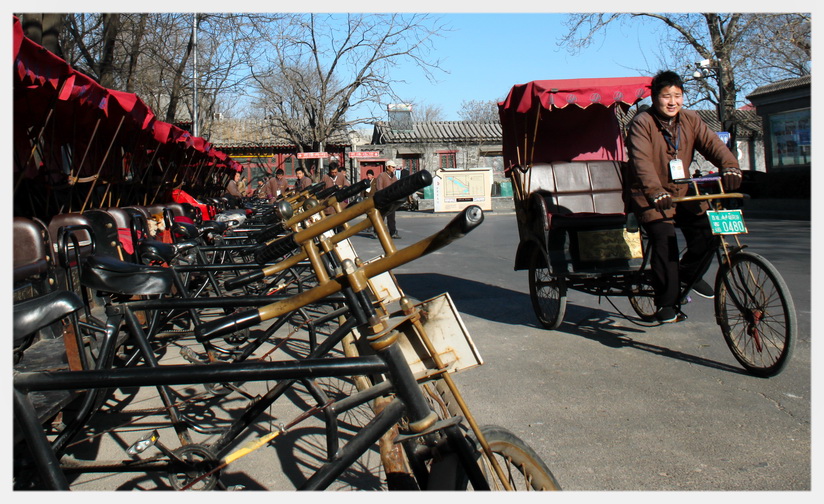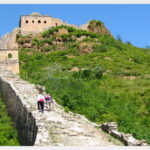Beijing is a city of contrasts, harmoniously blending its rich history and vibrant cultural heritage with modern innovations. It offers a wide array of experiences, making it a fascinating destination to visit and explore.
Choose some of the best 16 things to do in Beijing, you can immerse yourself in the historical, cultural, and culinary wonders that Beijing has to offer.
1. Visit the Forbidden City
The Forbidden City, also known as the Palace Museum, is an imperial palace complex that served as the residence of Chinese emperors during the Ming and Qing dynasties. It is situated in the heart of Beijing and is a UNESCO World Heritage site.
Exploring the Forbidden City allows visitors to immerse themselves in the monumental legacy of China’s imperial past, appreciate its architectural splendor, and gain a deeper understanding of the country’s rich history and culture.
2. Walk on the Great Wall
The Great Wall of China stretches over thousands of kilometers, and there are several accessible sections for visitors. Popular sections near Beijing include Badaling, Mutianyu, Simatai and Jinshanling. Try to find the section that best suits your preferences, whether you’re looking for a restored and easily accessible area or a more rugged and less crowded experience.
Badaling Great Wall: The most popular and gorgeous restored section of the Wall in Beijing, easily, accessible by bus and train, but it is usually very crowded. Badaling is also wheelchair friendly, accessible by the handicapped.
Mutianyu Great Wall: Beautiful green scenery and environment ( good for kids or seniors), less crowded, also wheel-chair user friendly.
3. Explore Tiananmen Square
Visit the historic Tiananmen Square, the world’s largest public square, and see landmarks like the Monument to the People’s Heroes.
Tiananmen Square is located in the heart of Beijing near the Forbidden City. You can easily reach there by taking a taxi or using the Beijing subway system (Tiananmen East or Tiananmen West stations).
If you visit early in the morning, you might be able to witness the daily flag raising ceremony at sunrise in front of Tiananmen Gate. It is a ceremonial event that attracts a large crowd, so plan to arrive early for a good spot.
4. Wander through the Hutongs
Take a rickshaw ride and wander through the traditional Hutongs, narrow alleyways showcasing Beijing’s local life and culture.
Hutongs have a history dating back over 700 years and are a part of Beijing’s cultural heritage. These narrow alleyways were originally formed by traditional courtyard homes, known as siheyuan, built during the Yuan, Ming, and Qing dynasties.
Visiting the Hutongs of Beijing offers a chance to immerse yourself in the city’s rich cultural heritage and experience a traditional way of life that is quickly disappearing. It allows you to appreciate the unique charm and authenticity that these alleyways provide, offering a contrast to the modern development of the city.
5. Discover the Summer Palace
Enjoy the scenic Summer Palace, a vast imperial garden retreat with beautiful pavilions, bridges, and a serene lake.
The Summer Palace was originally built in the 18th century during the Qing Dynasty as a royal retreat for emperors and their families to escape the summer heat of the capital city. It served as a place of relaxation, entertainment, and political activities.
The Summer Palace is not only a masterpiece of imperial garden design but also a reflection of Chinese history and culture. It offers a serene and enchanting escape from the bustling city, allowing visitors to appreciate the harmonious blend of nature and human creativity.
6. Experience the Temple of Heaven
Visit the Temple of Heaven, a revered religious site where emperors once performed ceremonies to ensure good harvests.
The Temple of Heaven was declared a UNESCO World Heritage site in 1998. It is recognized for its architectural and cultural significance, representing the finest example of ancient Chinese sacrificial buildings.
The Temple of Heaven stands as a testament to China’s rich cultural heritage and the importance placed on the relationship between humans and the divine. Its architectural beauty, serene surroundings, and historical significance make it a captivating destination for both locals and tourists in Beijing.
7. Explore the Lama Temple
Marvel at the Lama Temple (Yonghe Temple), one of the largest Tibetan Buddhist monasteries outside Tibet, known for its beautiful architecture and artwork.
The Lama Temple was originally built in 1694 as the residence of Emperor Yongzheng before he ascended the throne. However, in 1744, it was converted into a lamasery, making it the largest Tibetan Buddhist temple outside of Tibet.
Tibetan Buddhism Influence: The Lama Temple follows the Tibetan Buddhist tradition of the Gelug sect, also known as the Yellow Hat sect. It is a place of worship for Tibetan Buddhists and attracts visitors from around the world.
8. Discover the 798 Art District
Explore the contemporary art scene at the 798 Art District, a former industrial area transformed into a thriving art district with galleries, studios, and cafes.
In the late 1990s, the factory complex gradually became abandoned. Artists and art organizations began moving in, attracted by the large, open spaces and affordable rent. It evolved into an avant-garde art community and has since grown into one of Beijing’s most vibrant creative districts.
The 798 Art District exemplifies Beijing’s dynamic contemporary art scene, showcasing innovative works and fostering artistic expression. It provides a space for the city’s creative community to thrive and invites visitors to immerse themselves in a world of artistic exploration, cultural events, and creative energy.
9. See the Birds Nest and Water Cube
Visit the iconic Beijing National Stadium (Bird’s Nest) and National Aquatics Center (Water Cube), built for the 2008 Olympics.
The Birds Nest served as the main stadium for the 2008 Beijing Olympics, hosting the opening and closing ceremonies, as well as the track and field events. Since then, it has been used for various sporting, cultural, and entertainment events, including concerts and soccer matches.
The Water Cube, officially known as the Beijing National Aquatics Center, was designed by a consortium of Chinese and international architects, including PTW Architects from Australia. Its innovative design was inspired by soap bubbles.
10. Visit the National Museum of China
Explore the National Museum of China, the largest museum in the country, housing an extensive collection of artifacts and exhibitions on Chinese history and culture.
The museum offers various amenities, including spacious exhibition halls, audio guides, souvenir shops, a café, and a restaurant. It strives to create a comfortable and enriching experience for its visitors.
The National Museum of China serves as a vital cultural institution, preserving and showcasing China’s rich historical and artistic heritage. Its diverse exhibitions, grand architecture, and exceptional collection of treasures make it a must-visit destination for those seeking to explore and appreciate China’s profound cultural legacy.
11. Shop at Wangfujing Street
Stroll along Wangfujing Street, a vibrant shopping area with a mix of modern malls, traditional stores, and local street food stalls.
Wangfujing Street has a long history dating back over 700 years. It was originally a commercial center during the Ming Dynasty and served as a hub for government officials and foreign tourists during the Qing Dynasty.
Location: Wangfujing Street is situated in the Dongcheng District of Beijing, close to several major attractions such as the Forbidden City, Tiananmen Square, and the Temple of Heaven.
12. Experience Old Beijing at Qianmen Street
Immerse yourself in traditional Beijing culture at Qianmen Street, a historic area known for its traditional architecture, shops, and tasty snacks.
Qianmen Street has a rich history dating back over 500 years. It was originally built during the Ming Dynasty and served as the southern gate of Beijing’s inner city. It was a major thoroughfare during imperial times and an important commercial hub.
Qianmen Street merges history, commerce, and cultural heritage, making it a popular destination for tourists and locals alike. Visitors can stroll along the street, soak in the historical atmosphere, indulge in local delicacies, and explore unique shops and attractions that celebrate China’s vibrant past.
13. Enjoy a Peking Opera Show
Witness the elaborate costumes, singing, and acrobatics of the Peking Opera, a traditional Chinese theatrical art form.
Peking Opera shows can be enjoyed at various venues in Beijing, including theaters, opera houses, and cultural centers. Some popular venues for Peking Opera shows in Beijing are Liyuan Theater, Beijing Opera Theater, and Huguang Guild Hall.
Watching a Peking Opera show in Beijing provides an opportunity to witness a centuries-old art form that reflects the depth and beauty of Chinese culture. It is a chance to enjoy the mesmerizing performances, rich storytelling, and exquisite aesthetics that have captivated audiences for generations.
14. Explore the Beihai Park
Visit the scenic Beihai Park, an imperial garden featuring beautiful gardens, palaces, and a large lake with boating opportunities.
Beihai Park has a history dating back over a thousand years and was first built during the Liao Dynasty (907-1125). It served as an imperial garden during the Jin, Yuan, Ming, and Qing dynasties.
Visiting Beihai Park allows visitors to step back in time and experience the historical and natural beauty of a Chinese imperial garden. Its combination of stunning landscapes, architectural charm, and cultural significance make it a popular destination for leisurely walks, relaxation, and exploration of China’s rich heritage.
15. Visit the Confucius Temple and Imperial Academy
Pay a visit to the Confucius Temple and Imperial Academy (the Guozijian), dedicated to the sage Confucius and ancient education.
The Confucius Temple and Imperial Academy complex is an important cultural and educational center that dates back over 700 years. It was established during the Yuan Dynasty and served as the highest seat of learning in ancient China.
The Confucius Temple and Imperial Academy complex offers a glimpse into the profound influence of Confucianism and Chinese education in ancient times. It is a place where visitors can appreciate the architectural beauty, explore Confucian teachings, and gain insight into the rich cultural heritage of China.
16. Sample Beijing Cuisine
Indulge in iconic Beijing dishes like Peking duck, dumplings, hot pot, and street food delicacies, experiencing the rich culinary heritage of the city.
Beijing cuisine, also known as Jing cuisine, is a culinary style that originates from the city of Beijing, China. It has a long history and is known for its rich flavors, careful preparation, and skilled culinary techniques. Here is some information about Beijing cuisines.
Trying Beijing cuisine provides a delightful opportunity to experience the rich culinary heritage of the Chinese capital. Whether indulging in the iconic Peking Roast Duck or exploring the diverse street food scene, Beijing cuisine offers a tantalizing blend of flavors and a unique insight into the city’s culinary traditions.
With these 16 activities, you can immerse yourself in the historical, cultural, and culinary wonders that Beijing has to offer.
If you have any questions or queries, then please feel free to drop us a line.


